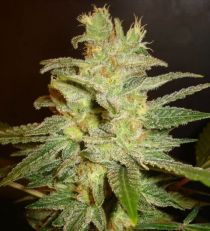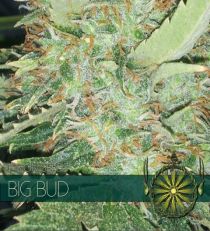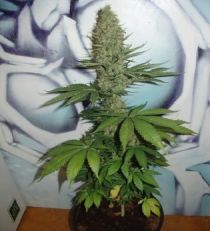 White Widow x Big Bud by Female Seeds By Female SeedsFrom: US$23.50
White Widow x Big Bud by Female Seeds By Female SeedsFrom: US$23.50- THC: 18%-20%
- Yield: Over 600gr/m²
- Flowering Time: 6-8 Weeks
 Northern Light x Big Bud Ryder by W.O.S. Seeds By World Of SeedsFrom: US$27.31
Northern Light x Big Bud Ryder by W.O.S. Seeds By World Of SeedsFrom: US$27.31- THC: 15%-18%
- Yield: 500-600gr/m²
- Flowering Time: 10-12 Weeks
 Northern Light x Big Bud Feminized by W.O.S. Seeds By World Of SeedsFrom: US$28.58
Northern Light x Big Bud Feminized by W.O.S. Seeds By World Of SeedsFrom: US$28.58- THC: 19%-22%
- Yield: 500-600gr/m²
- Flowering Time: 10-12 Weeks
 Big Bud Feminized by Vision Seeds By Vision SeedsFrom: US$25.40
Big Bud Feminized by Vision Seeds By Vision SeedsFrom: US$25.40- THC: 15%-18%
- Yield: 500-600gr/m²
- Flowering Time: 10-12 Weeks
 Big Bud XXL Feminized by MOC Seeds By Ministry Of cannabisFrom: US$19.05
Big Bud XXL Feminized by MOC Seeds By Ministry Of cannabisFrom: US$19.05- THC: 15%-18%
- Yield: 500-600gr/m²
- Flowering Time: 8-10 Weeks
 Big Bud Regular - H Fantaseeds - 5 SeedsFrom: US$25.39
Big Bud Regular - H Fantaseeds - 5 SeedsFrom: US$25.39- THC: 15%-18%
- Yield:
- Flowering Time: 10-12 Weeks
 Big Bud Feminized - H Fantaseeds - 5 SeedsFrom: US$46.98
Big Bud Feminized - H Fantaseeds - 5 SeedsFrom: US$46.98- THC: 15%-18%
- Yield:
- Flowering Time: 10-12 Weeks
 Pre-99 Big Bud Feminized - Nirvana Seeds By NirvanaFrom: US$23.75
Pre-99 Big Bud Feminized - Nirvana Seeds By NirvanaFrom: US$23.75- THC: 15%-18%
- Yield: 500-600gr/m²
- Flowering Time: 10-12 Weeks
 Big Bud Regular - Sensi Seeds By Sensi SeedsFrom: US$107.70
Big Bud Regular - Sensi Seeds By Sensi SeedsFrom: US$107.70- THC: 15%-18%
- Yield: Over 600gr/m²
- Flowering Time: 10-12 Weeks
 Big Bud Feminized - Sensi Seeds By Sensi SeedsFrom: US$39.05
Big Bud Feminized - Sensi Seeds By Sensi SeedsFrom: US$39.05- THC: 15%-18%
- Yield: Over 600gr/m²
- Flowering Time: 8-10 Weeks
 Big Bud XXL Feminized - Ministry Of CannabisFrom: US$16.27
Big Bud XXL Feminized - Ministry Of CannabisFrom: US$16.27- THC: 15%-18%
- Yield: Over 600gr/m²
- Flowering Time:
 Big Bud Feminized - 5 Seeds By 420 SeedbankFrom: US$52.07
Big Bud Feminized - 5 Seeds By 420 SeedbankFrom: US$52.07- THC: 15%-18%
- Yield: 500-600gr/m²
- Flowering Time: 10-12 Weeks
 Big Bud Regular - 10 Seeds By 420 SeedbankFrom: US$36.83
Big Bud Regular - 10 Seeds By 420 SeedbankFrom: US$36.83- THC: 15%-18%
- Yield: 500-600gr/m²
- Flowering Time: 10-12 Weeks
 Big Bud Feminized by MSNL Seeds By MSNL SeedsFrom: US$41.15
Big Bud Feminized by MSNL Seeds By MSNL SeedsFrom: US$41.15- THC: 16%-19%
- Yield: 500-600gr/m²
- Flowering Time: 8-10 Weeks
Big Bud Seeds
Ready to grow some massive buds? Then you're in the right place! Big Bud Seeds are a must-have for anyone looking to maximize their harvest. As the name suggests, these seeds produce thick, dense buds that pack a punch in both size and potency. Whether you're a newbie grower or have been cultivating cannabis for years, Big Bud Seeds are a reliable option for heavy yields and straightforward growth. Let's dive into what makes these seeds a classic choice for growers everywhere.
Big Bud Strain Overview
Genetic Background and History of Big Bud
Big Bud has been around since the '80s, so it's safe to say it's got some old-school cred. This strain originated from a mix of Afghan, Northern Lights, and Skunk #1 genetics, creating a powerhouse of dense buds and high yields. If you're into cannabis history, this strain is like a blast from the past! It’s all about providing you with the nostalgic effects of the original, while modern breeding has enhanced its potency and yield potential.
Key Features of Big Bud Strain
This strain lives up to its name! Big Bud plants are known for their chunky, resin-coated buds that practically glow with potency. The plants grow tall with a bushy structure, making them perfect for those who want to get the most out of their grow space. Not to mention, Big Bud offers a balanced high that blends relaxation with a touch of euphoria—ideal for unwinding after a long day.
Why Choose Big Bud Seeds for Cultivation?
Big Bud is perfect if you’re aiming for a bumper harvest without the fuss. These seeds are resilient, adaptable to various growing environments, and don’t require a ton of maintenance. Plus, they have a relatively short flowering period, so you won’t be waiting forever to reap the rewards. If you’re looking for a no-nonsense strain that gives you big yields with minimal hassle, Big Bud is your go-to.
Growing Big Bud Seeds – Indoor and Outdoor Tips
Ideal Climate and Environment for Big Bud Seeds
Big Bud thrives in a warm, Mediterranean-like climate with plenty of sunshine. If you're growing indoors, keep the temperature between 70-80°F and maintain humidity levels around 50-60% during the vegetative stage. When it comes to outdoor growing, the best time to plant is in early spring, with a harvest window that typically lands in October.
Best Growing Mediums for Maximum Yield
I always recommend using a high-quality soil mix with plenty of organic nutrients if you’re looking for a straightforward option. If you’re more experienced, hydroponics can really boost Big Bud’s growth speed and yield potential. Coco coir is another great option, offering an excellent balance of moisture retention and aeration for the roots. Just keep it simple: a well-draining medium and consistent feeding are key.
Indoor vs. Outdoor Cultivation: Pros and Cons
- Indoor: Easier to control the growing environment, which is ideal for maximizing yields. Plus, you can grow year-round.
- Outdoor: Lower cost and higher yields, thanks to the natural sunlight. However, it’s riskier due to weather fluctuations and pests.
Nutrient Requirements and Feeding Schedule
Big Bud is a heavy feeder, so you'll want to keep it well-supplied with nitrogen during the vegetative stage. As it enters flowering, switch to a bloom-focused nutrient mix rich in phosphorus and potassium. I suggest feeding your plants every 1-2 weeks, adjusting based on their growth stage and any signs of nutrient deficiencies. And don’t forget: flushing your plants with pure water a week before harvest can enhance the flavor and potency!
Light Cycle and Photoperiod for Optimal Growth
For indoor growers, keep Big Bud in an 18/6 light cycle (18 hours of light, 6 hours of darkness) during the vegetative stage. When you're ready to flower, switch to a 12/12 cycle. Outdoor growers can let nature handle the light cycle; just make sure you’re planting during the season that matches the plant's flowering schedule.
Common Growing Issues and How to Avoid Them
Big Bud is pretty sturdy, but watch out for mold and mildew due to its dense buds. Keep airflow up and humidity down, especially during the flowering phase. Spider mites can also be an issue, so inspect your plants regularly and use natural pest control methods if needed. Prevention is the name of the game here—healthy plants are less likely to run into trouble.
Flowering Time and Harvesting Big Bud
Flowering Duration for Big Bud Seeds
Big Bud has a relatively short flowering period, usually between 7-9 weeks. For outdoor growers, expect to harvest around mid to late October. Indoors, you can manipulate the light cycle to get them to flower quicker, but I recommend being patient to get the fullest buds possible.
Signs That Your Big Bud Plants Are Ready for Harvest
You’ll know your Big Bud plants are ready when the pistils (those little hair-like structures) start to turn amber, and the trichomes shift from a clear to a milky-white color. This is the sweet spot for harvesting if you’re aiming for maximum potency. If you’re looking for a more relaxed effect, wait until the trichomes turn slightly amber.
How to Harvest Big Bud for Maximum Potency and Yield
Cut down the main stems with a pair of sharp, clean scissors, leaving some extra stem for hanging. Trim away the larger fan leaves, but leave the smaller sugar leaves intact for now. Hang the branches upside down in a dark, well-ventilated space to dry for about 7-10 days.
Post-Harvest Care – Drying, Curing, and Storing
Proper Drying Techniques for Big Bud Buds
After you’ve harvested, drying is the first step. Hang the buds upside down in a dark room with a temperature of around 60-70°F and humidity levels at 50-60%. This slow drying process helps to preserve terpenes and flavor, so don’t rush it!
Curing Process to Enhance Flavor and Potency
Once the buds are dry, transfer them to airtight glass jars. Store these jars in a cool, dark place and “burp” them daily for the first couple of weeks. This means opening the jar for a few minutes to let out moisture. Curing for at least 2-4 weeks will bring out the best in your buds.
Best Storage Practices to Maintain Freshness
Store your cured buds in airtight containers, away from light, heat, and humidity. I always use glass jars with a sealable lid. If you want to go the extra mile, throw in a humidity control pack to keep the buds fresh for the long haul.
Big Bud Seeds – Effects, Flavors, and Potency
What to Expect: Effects of Big Bud Strain
Big Bud is known for its relaxing, almost sedative effects that melt away stress. It's the perfect strain to chill out with at the end of a long day. You'll also get a euphoric head buzz, which can enhance your mood without knocking you out completely.
Flavor Profile and Aroma of Big Bud
This strain has a sweet, earthy flavor with a hint of spice. The aroma is equally enticing, blending skunky, musky notes with a touch of sweetness. Think of it as a mix of classic cannabis scent with a modern twist.
THC and CBD Content in Big Bud Seeds
Big Bud typically boasts a THC content ranging between 15-20%, providing a potent but manageable high. CBD levels are usually low, around 1%, so it’s more about relaxation than therapeutic effects.
Where to Buy Quality Big Bud Seeds
Selecting a Reliable Seed Bank
Always buy your seeds from a reputable seed bank. Look for one that offers quality guarantees and has plenty of positive customer reviews. A good seed bank will also provide information on the genetics and germination rates of their seeds.
Factors to Consider When Purchasing Big Bud Seeds
- Feminized vs. Regular Seeds: Feminized seeds ensure you’ll grow female plants, which produce the buds you’re after.
- Shipping Discretion: Make sure the seed bank offers stealth shipping to protect your privacy.
- Germination Guarantee: A reliable seed bank often offers a guarantee on the germination rate of their seeds.
What are the main characteristics of Big Bud seeds?
Large, dense buds with a high yield, sweet and earthy aroma, and relaxing effects.
How much yield can I expect from Big Bud plants?
Indoors, 500-600g/m²; outdoors, up to 800g per plant under optimal conditions.
Is Big Bud suitable for beginner growers?
Yes, it’s easy to grow and forgiving of common mistakes, making it ideal for beginners.
How long does Big Bud take to flower?
Typically, it takes about 7-9 weeks to flower.
What is the THC level of Big Bud?
THC content ranges from 15-20%, providing a potent but balanced high.











